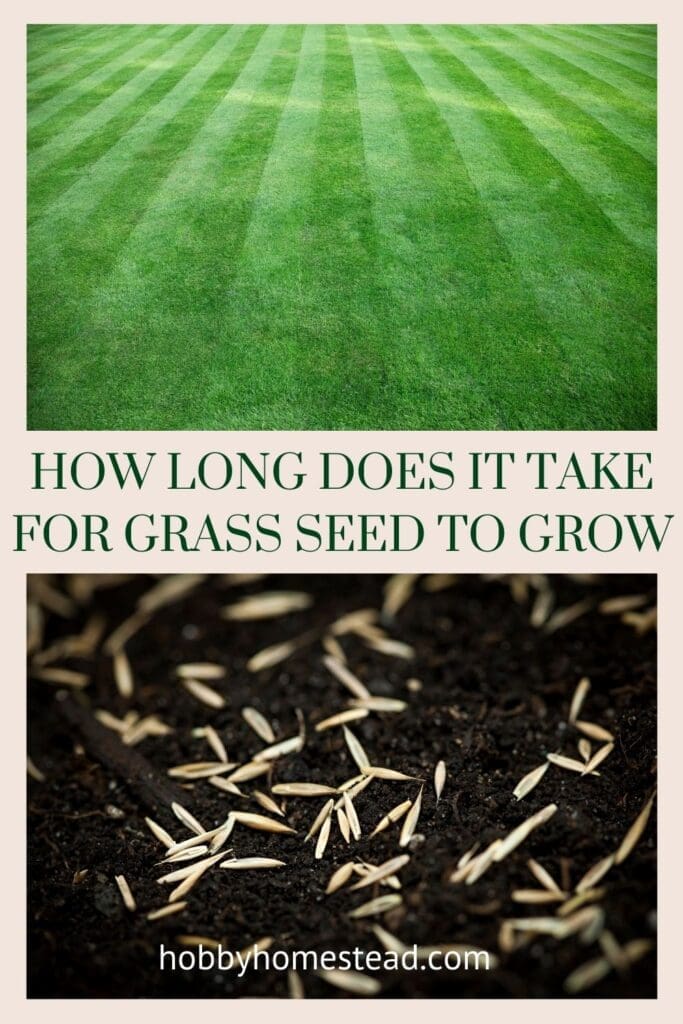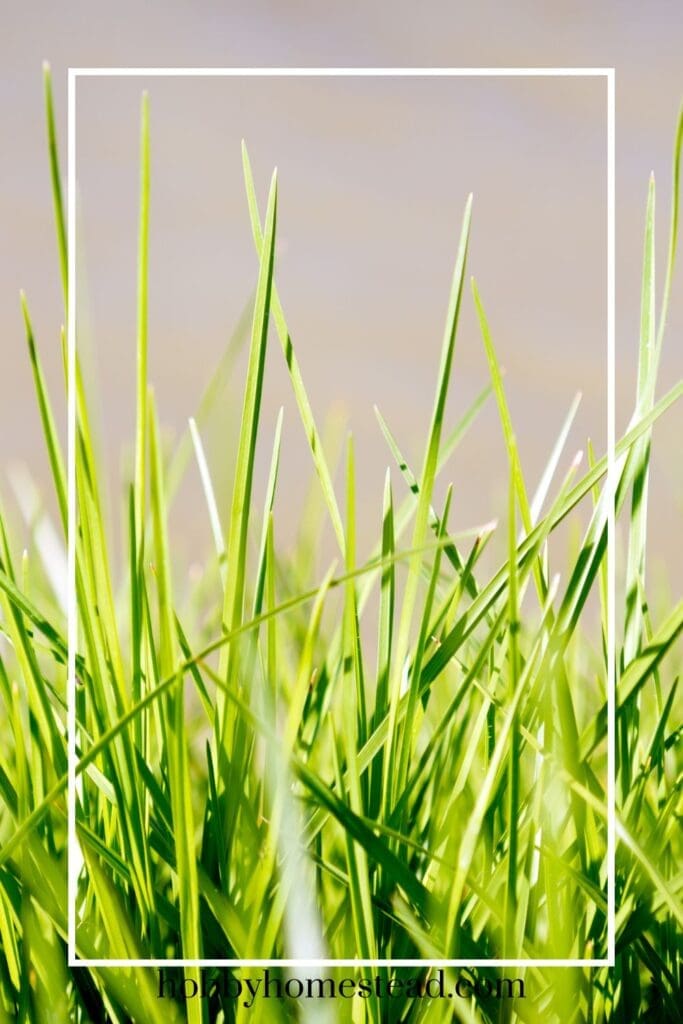Last updated on April 25th, 2025 at 09:57 am
If you’ve ever planted grass seed and wondered how long it takes for grass seed to grow, you’re not alone. After building our home, we had to seed an entire new lawn from scratch. We consulted with professionals to make sure we got the best results, and as we continue to tackle new projects around the farm, we plant new grass as needed. From filling in bare spots to starting a lush lawn from seed, we’ve learned that grass seed germination depends on several factors, including the type of grass seed, soil quality, and weather conditions.
Fast Facts: How Long Grass Seed Takes to Grow
When you’re planting grass seed in your yard, sometimes, it seems like it takes forever to grow. Your new grass seed will start growing in about 10-14 days, but know that sometimes it can take up to 30 days.

Table of contents
How Long Does Grass Seed Take to Grow?
The length of time it takes for grass seed germination depends on the grass species and growing conditions. Here’s a general breakdown of germination times for common grass seed types:
- Kentucky bluegrass: 14-30 days
- Perennial ryegrass: 5-10 days (one of the fastest germinating seeds)
- Tall fescue: 7-12 days
- Red fescue: 12-22 days
- Bermuda grass: 10-30 days (depending on temperature)
Factors like soil moisture, air temperatures, and soil conditions will affect the grass growth rate. Cool-season grass seed thrives in early autumn and early spring, while warm-season varieties grow best in late spring and early summer when higher temperatures promote growth. Understanding the germination process will help you determine the best time to plant and ensure successful growth.
Establishing a Healthy Lawn
Establishing a healthy, thriving lawn or pasture is an important part of any homestead. Whether you’re creating a green space for your family, providing grazing for livestock, or improving soil stability, understanding how long it takes for new grass to grow. Even knowing how to speed up the process can make all the difference.
Key Factors That Influence Grass Growth
Several factors influence growth time, from seed type to soil health and weather patterns. Here’s what you need to know to get the best results for your homestead.
Growing grass successfully on your homestead requires careful planning and patience. Keep these essential factors in mind:
- Grass Seed Type: Different grass varieties have different germination times.
- Germination Conditions: Soil temperature, moisture levels, and seed depth play a role.
- Weather Patterns: Temperature fluctuations and rainfall impact growth speed.
- Soil Health: Proper preparation ensures nutrient availability for young grass.
Let’s break down each factor to help you establish a vibrant, healthy lawn or pasture.
Step-by-Step Guide to Planting Grass Seed
For a healthy lawn, follow these best practices when planting grass seed.
Choose the Right Grass Seed
Select the grass seed type that matches your climate and lawn needs. Cool-season grasses like Jonathan Green Black Beauty or Kentucky bluegrass work well in northern areas, while warm-season grass seeds like Bermuda grass are better suited for southern regions.
The type of grass seed you select will determine how quickly your new lawn or pasture takes root. Homesteaders in cooler climates should opt for cool-season grasses, while those in warmer regions will do better with warm-season varieties.
Common cool-season grasses (best for northern climates):
- Ryegrass: Germinates in 5-10 days.
- Fescue: Germinates in 7-14 days.
- Bentgrass: Germinates in 10-14 days.
- Kentucky Bluegrass: Germinates in 14-30 days.
Common warm-season grasses (best for southern climates):
- Bermudagrass: Germinates in 10-30 days.
- Zoysia Grass: Germinates in 14-21 days.
- Buffalograss: Germinates in 14-30 days.
For homesteaders raising animals, consider pasture-friendly grass blends that include clover, alfalfa, or orchard grass to provide grazing options.
Timing your planting according to the weather is crucial. Grass grows best when soil temperatures range between 50-65°F. Avoid planting during extreme heat or cold, as seeds may struggle to germinate.
For homesteaders, observing seasonal weather patterns is key. Planting in early fall or spring gives your grass the best chance to establish before facing harsh weather.
Prepare the Soil
- Conduct a soil test to check for essential nutrients.
- Rake the soil surface to remove debris and loosen compacted areas.
- Mix in peat moss or compost to improve soil quality.
Spread the Grass Seed
- Use a seed mix or a single grass species, depending on your lawn’s needs.
- Spread evenly using a broadcast spreader.
- Lightly rake to ensure good seed-to-soil contact.
Cover and Water
- Cover the seeded area with clean straw or mulch to retain soil moisture and protect from heavy rains.
- Water lightly 1-2 times per day until germination.
- Keep the top inch of soil moist but avoid oversaturation.
- Reduce watering frequency as the grass matures to encourage deep roots.
- Avoid overwatering, as too much water can wash away newly-planted seeds.
How to Speed Up Grass Seed Germination
For successful germination, follow these best ways to accelerate the growing season.
- Plant at the right time. Cool-season grass seed should be planted in early fall or early spring, while warm-season grasses do best in late spring or early summer.
- Keep soil consistently moist. Avoid letting the soil surface dry out.
- Use a starter fertilizer. Provides the nutrients needed for healthy growth.
- Ensure proper soil preparation. Aerate compacted areas to create ideal conditions.
- Choose fast-germinating varieties. Perennial ryegrass and tall fescue have higher germination rates.
Fertilization and Natural Soil Boosters
For a sustainable approach, consider these natural fertilizers:
- Compost Tea: Provides slow-release nutrients.
- Bone Meal: Boosts phosphorus for strong roots.
- Grass Clippings & Mulch: Retains moisture and enriches soil.
- Legume Cover Crops: Fix nitrogen into the soil.
Fertilize new grass lightly when seeding, then again after 4-6 weeks to encourage steady growth.

Protecting Your Grass from Pests and Livestock
Newly sprouted grass is vulnerable to pests and animals. Use these strategies to safeguard your lawn or pasture:
- Netting or Straw Mulch: Deters birds from eating seeds.
- Companion Planting: Marigolds or garlic can repel pests.
- Temporary Fencing: Keeps chickens, goats, or deer from grazing too soon.
Common Mistakes to Avoid
Avoid these errors when trying to grow a perfect lawn:
- Planting at the wrong time of year. Late summer or early autumn is ideal for cool-season grass seed.
- Too much seed. Overcrowding prevents grass seedlings from growing properly.
- Neglecting soil conditions. Poor soil can delay grass growth.
- Ignoring foot traffic. Keep off a newly-seeded lawn until fully established.
Grass Seeds are Not Germinating
It sounds like your grass seeds are not germinating as expected. Here are some potential reasons and solutions based on homesteading principles:
1. Soil Temperature Issues
Grass seeds require specific soil temperatures to germinate. If it’s too cold (below 50°F) or too hot (above 75°F for cool-season grasses), seeds may stay dormant.
✅ Solution: Use a soil thermometer to check temperatures. If it’s too cold, wait for warmer weather or use a clear plastic cover to trap heat.
2. Poor Seed-to-Soil Contact
Seeds need direct contact with soil to absorb moisture and nutrients. If they’re sitting on hard or compacted ground, they may dry out or wash away.
✅ Solution: Lightly rake seeds into the soil and press them down with a roller or your foot.
3. Overwatering or Underwatering
Seeds need consistent moisture but can rot if they stay too wet. Dry soil, on the other hand, halts germination.
✅ Solution: Water lightly 1-2 times daily until germination. Adjust based on weather—less in humid conditions, more in dry conditions.
4. Soil Health and pH Imbalance
Grass won’t germinate well in overly acidic or alkaline soil. Compacted, nutrient-poor soil also slows growth.
✅ Solution: Test your soil pH (aim for 6.0-7.2). If too acidic, add lime; if too alkaline, add sulfur. Improve soil with compost or organic matter.
5. Birds and Pests Eating Seeds
Wildlife may be feasting on your newly planted seeds before they have a chance to sprout.
✅ Solution: Use straw mulch, netting, or a light covering of compost to hide seeds from birds and rodents.
6. Wrong Grass Type for Your Region
Some grass varieties take longer to germinate or may not be suited for your climate.
✅ Solution: Choose grass adapted to your region. For cool climates, opt for Kentucky Bluegrass or Ryegrass. For warm regions, consider Bermudagrass or Buffalo Grass.
7. Expired or Poor-Quality Seeds
Old seeds may have low viability and fail to sprout.
✅ Solution: Check the seed bag for expiration dates. Buy fresh, high-quality seeds from a reputable supplier.

When Should New Grass be Mowed?
You should first mow new grass when it reaches about 3 to 4 inches in height. Mowing too soon can damage young roots, while waiting too long may cause the grass to become too thick and weak.
Key Tips for the First Mow:
Use sharp blades – Dull mower blades can tear new grass instead of cutting it cleanly.
Mow when the soil is dry – This helps prevent pulling up tender grass.
Follow the one-third rule – Never cut more than 1/3 of the blade height at once to reduce stress.
Set mower height high – Start with a higher setting and gradually lower it over time.
When Will Your Lawn Be Fully Established?
While grass blades may appear within a few weeks, it can take 6-8 weeks for a green lawn to fully develop. Factors such as weather conditions, soil moisture, and germination time all influence how quickly your new lawn takes shape.
For the best results, follow a lawn care routine, fertilize at the right time, and ensure proper soil preparation. With good practices, your newly seeded lawn will grow into a lush lawn that’s resilient and healthy.
Conclusion
Growing a healthy lawn takes patience, but with the right conditions and best practices, you’ll have a thriving lawn in no time. Whether you’re planting a new lawn, filling in bare spots, or overseeding an existing lawn, understanding the germination process is key.
References
Jonathan Green. How Long for Grass Seed to Germinate?
Grass Master. How Long Does It Take for New Grass to Grow?


